21 Jul 2019
Forty Hall Summer Dig - Day 6
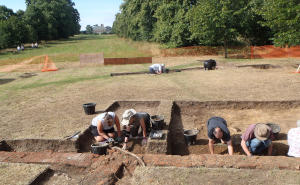
Fine weather and a cheerful mood marked the halfway point of our summer dig on the site of Henry VIII's Elsyng Palace, in the grounds of Forty Hall today, as we continued our exploration of the area in front of the 'Long Barn' - the storage building which once occupied the south side of the palace's outer court.
Two main goals of this year's dig were to determine whether there were ever any structures built up against the south side of the barn, to the east of the boiling house, which we excavated last year and we know is adjacent to the barn's west end, and secondly to find out if there was a boundary wall connected to the boiling house which continued east, into what is today Forty Hall's lime tree avenue.
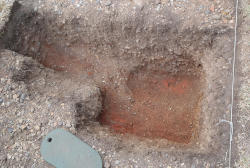
Until today trench one, which we opened on what should have been the line of the boundary wall, had revealed nothing but a sea of sterile gravel and we had begun to wonder whether the palace boundary followed an entirely different course, but happily our diggers' persistence paid off this afternoon when we finally found the remains of the wall, which has been so thoroughly robbed out that all that remains is a thick wedge of crushed brick dust at the base of what was once the wall's foundation.

Meanwhile, the west end of trench 2 continues to yield some complex but equally interesting archaeology. We finished removing the rubble fill which covered yesterday's newly discovered vaulted drain, finding that the cut extends right up to what we had been thinking of as a column base against the side of the barn. Examining it in detail, especially the mortar that it is made of, it became apparent that this piece of brickwork is older than the rest of the barn, most likely dating to the mid 15th century, when the house belonged the the Earl of Worcester, who is credited with building the first significantly high status house on the site.
It now seems as though there must have been a building that was knocked down before the barn was built, and this stub of wall survived, with the barn wall cutting through it, although what that building could have been is likely to remain a mystery at least for the time being.
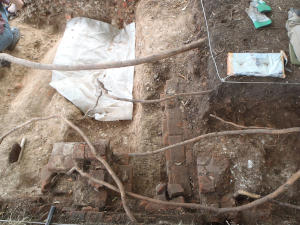
We also extended the trench west today, revealing more of the brickwork that had been in the trench's west section. The stub of brick that looked like it might be another column is in fact quite a thin stub of wall, and the bricks that we had thought might be a floor have turned out to have a second course beneath them, making them more likely to be a (poorly constructed) wall. There is a lot more work to do in this corner before we can make any sense of these features.
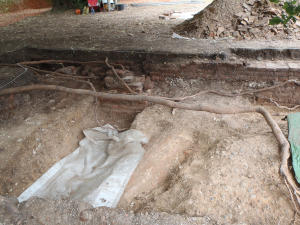
All of the coarse rubble fill over the drain has now been removed, and the mortar used in the drain construction also strongly points to a mid 15th century date. Excavation in front of the barn wall shows that its late 15th / early 16th century builders knew about the drain and incorporated a mortar filled gap in the barn's wall to allow the drain to pass through. It's highly probable that the drain falls in that direction (north) and ultimately discharges into Maiden's Brook.
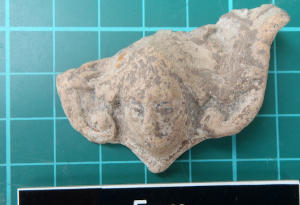
Today's star find also came from the rubble deposit on top of the drain - a small ornamental lead chrub or angel's head which traces of what look like wings.
We think it may have been a decorative feature on something like a lead water spout - a pipe which would have carried rainwater from the gutters of the palace roof clear of the walls.
Tomorrow we'll be taking a day off to rest and catch up on finds processing and paperwork, but we'll be back on Tuesday.